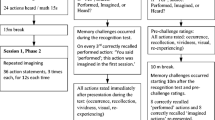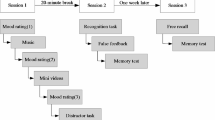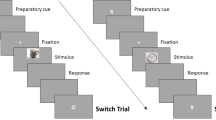Abstract
Memories that can be recalled but are no longer believed are termed nonbelieved memories. The current studies examined the creation of emotionally negative nonbelieved memories after viewing negatively valenced pictures. In both experiments, participants took part in two sessions. In Session 1, after being presented with a set of neutral and negative pictures, participants had to rate their emotional state. One week later, in Session 2, participants had to complete a recognition task to identify pictures that had appeared during the previous session. During this task, participants’ memories for some pictures were challenged by telling them that their answers were incorrect in order to evoke nonbelieved memories. The experimental procedure was successful in creating nonbelieved memories in the participants. Specifically, in Experiment 1 (N = 35), we induced nonbelieved true memories for both negative and neutral pictures. We found a significant decrease in both belief and recollection after the challenge, with the change in belief being twice as large as the change in recollection. In Experiment 2 (N = 43), we successfully induced both nonbelieved true and false memories for negative pictures. Again, the reduction of belief was significantly greater than that of recollection. In general, participants evinced better memory for negative pictures, but following challenges people were just as likely to accept false social feedback and change their memories regarding other types of pictures. In both experiments, our challenges did not lead to notable changes in emotional state. In general, our findings show that emotionally negative nonbelieved memories can be successfully evoked in an experimental setting.




Similar content being viewed by others
Data Availability
All data are available at https://osf.io/jdu45/.
References
Baptie, G., Andrade, J., Bacon, A. M., & Norman, A. (2021). Virtually renovating the trauma film paradigm: Comparing virtual reality with on-screen presentation of an analogue trauma. Cyberpsychology: Journal of Psychosocial Research on Cyberspace, 15(1), 6. https://doi.org/10.5817/CP2021-1-6
Beck, A. T., Steer, A., & Brown, K. (1996). Beck depression inventory–II. Harcourt Brace.
Bernstein, D. M., Scoboria, A., & Arnold, R. (2015). The consequences of suggesting false childhood food events. Acta Psychologica, 156, 1–7.
Blanchette, I., & Caparos, S. (2013). When emotions improve reasoning: The possible roles of relevance and utility. Thinking & Reasoning, 19(3/4), 399–413.
Bower, G. H. (1981). Mood and memory. American Psychologist, 36(2), 129.
Brédart, S., & Bouffier, M. (2016). Nonbelieved memories in middle-aged and older people. Consciousness andCognition, 42, 352–357.
Brewer, W. F. (1996). What is recollective memory? In D. C. Rubin (Ed.), Remembering our past: Studies in autobiographical memory (pp. 19–66). Cambridge University Press.
Brewin, C. R. (2015). Re-experiencing traumatic events in PTSD: New avenues in research on intrusive memories and flashbacks. European Journal of Psychotraumatology, 6(1), 27180.
Brewin, C. R., & Langley, K. M. (2019). Imagery retrieval may explain why recall of negative scenes contains moreaccurate detail. Memory & Cognition, 47, 420–427.
Brewin, C. R., Gregory, J. D., Lipton, M., & Burgess, N. (2010). Intrusive images in psychological disorders: Characteristics, neural mechanisms, and treatment implications. Psychological Review, 117(1), 210.
Carlson, E. B., Smith, S. R., Palmieri, P. A., Dalenberg, C., Ruzek, J. I., Kimerling, R., Burling, T. A., & Spainet, D. A. (2011). Development and validation of a brief self-report measure of trauma exposure: The trauma history screen. Psychological Assessment, 23, 463–477.
Christianson, S. -Å. (1992). Emotional stress and eyewitness memory: A critical review. Psychological Bulletin, 112(2), 284–309.
Christianson, S. Å., & Loftus, E. F. (1987). Memory for traumatic events. Applied Cognitive Psychology, 1(4), 225–239.
Clark, A., Nash, R. A., Fincham, G., & Mazzoni, G. (2012). Creating non-believed memories for recent autobiographical events. PLOS ONE, 7(3), e32998.
Cuperus, A. A., Klaassen, F., Hagenaars, M. A., & Engelhard, I. M. (2017). A virtual reality paradigm as an analogue to real-life trauma: Its effectiveness compared with the trauma film paradigm. European Journal of Psychotraumatology, 8(Suppl. 1), 1338106.
Davis, M. I., & Clark, D. M. (1998). Predictors of analogue post-traumatic intrusive cognitions. Behavioural and Cognitive Psychotherapy, 26(4), 303–314.
Elsey, J. W., Van Ast, V. A., & Kindt, M. (2018). Human memory reconsolidation: A guiding framework and critical review of the evidence. Psychological Bulletin, 144(8), 797.
Faul, F., Erdfelder, E., Lang, A.-G., & Buchner, A. (2007). G*Power 3: A flexible statistical power analysis program for the social, behavioral, and biomedical sciences. Behavior Research Methods, 39, 175–191.
Frijda, N. H., Manstead, A. S. R., & Bem, S. (2000). The influence of emotions on beliefs. In N. H. Frijda, A. S. R. Manstead, & S. Bem (Eds.), Emotions and beliefs: How feelings influence thoughts (pp. 1–9). Cambridge University Press.
Gilbert, P., McEwan, K., Matos, M., & Rivis, A. (2011). Fears of compassion: Development of three self-report measures. Psychology and Psychotherapy: Theory, Research and Practice, 84(3), 239–255.
Goff, L. M., & Roediger, H. L. (1998). Imagination inflation for action event: Repeated imaginings lead to illusory recollections. Memory & Cognition, 26, 20–33.
Gudjonsson, G. H. (1997). False memory syndrome and the retractors. Psychological Inquiry, 8, 296–299.
Horowitz, M. (1986). Stress-response syndromes: A review of post-traumatic and adjustment disorders. Hospital and Community Psychiatry, 37, 241–249.
Houle, I., & Philippe, F. L. (2020). Is the negative always that bad? Or how emotion regulation and integration of negative memories can positively affect well-being. Journal of Personality, 88(5), 965–977.
James, W. (1890). The principles of psychology (Vol. 1). Dover.
Johnson, M. K., Foley, M. A., Suengas, A. G., & Raye, C. L. (1988). Phenomenal characteristics of memories for perceived and imagined autobiographical events. Journal of Experimental Psychology: General, 117, 371–376.
Kensinger, E. A., & Corkin, S. (2003). Effect of negative emotional content on working memory and long-term memory. Emotion, 3(4), 379–393.
Kensinger, E. A., & Schacter, D. L. (2006). Processing emotional pictures and words: Effects of valence and arousal. Cognitive, Affective, & Behavioral Neuroscience, 6(2), 110–126.
Kneeland, E. T., Nolen-Hoeksema, S., Dovidio, J. F., & Gruber, J. (2016). Beliefs about emotion’s malleability influence state emotion regulation. Motivation and Emotion, 40, 740–749.
Kurdi, B., Lozano, S., & Banaji, M. R. (2017). Introducing the open affective standardized image set (OASIS). Behavior Research Methods, 49(2), 457–470.
Li, C., Wang, J., & Otgaar, H. (2020). Creating nonbelieved memories for bizarre actions using an imagination inflation procedure. Applied Cognitive Psychology, 34(6), 1277–1286.
Magee, J. C., Harden, K. P., & Teachman, B. A. (2012). Psychopathology and thought suppression: A quantitative review. Clinical Psychology Review, 32(3), 189–201.
Mather, M. (2006). Why memories may become more positive as people age. In B. Uttl, N. Ohta, & A. Siegenthale (Eds.), Memory and emotion: Interdisciplinary perspectives (pp. 135–158). Blackwell.
Mazzoni, G., Scoboria, A., & Harvey, L. (2010). Nonbelieved memories. Psychological Science, 21, 1334–1340.
Mazzoni, G., Vannucci, M., & Batool, I. (2014). Manipulating cues in involuntary autobiographical memory: Verbalcues are more effective than pictorial cues. Memory & cognition, 42, 1076–1085.
McConnell, A. R., & Strain, L. M. (2007). Content and structure of the self-concept. In C. Sedikides & S. J. Spencer (Eds.), The self (pp. 51–73). Psychology Press.
McNally, R. J. (2003). Remembering trauma. Harvard University Press.
Ochsner, K. N. (2000). Are affective events richly recollected or simply familiar? The experience and process ofrecognizing feelings past. Journal of Experimental Psychology: General, 129(2), 242.
Otgaar, H., Scoboria, A., & Smeets, T. (2013). Experimentally evoking nonbelieved memories for childhood events. Journal of Experimental Psychology Learning Memory & Cognition, 39(3), 717–730.
Otgaar, H., Howe, M. L., Memon, A., & Wang, J. (2014). The development of differential mnemonic effects of false denials and forced confabulations. Behavioral Sciences & the Law, 32(6), 718–731.
Otgaar, H., Scoboria, A., Howe, M. L., Moldoveanu, G., & Smeets, T. (2016). Challenging memories in children and adults using an imagination inflation procedure. Psychology of Consciousness: Theory, Research, and Practice, 3, 270–283.
Otgaar, H., Moldoveanu, G., Wang, J., & Howe, M. L. (2017). Exploring the consequences of nonbelieved memories in the DRM paradigm. Memory, 25, 922–933.
Otgaar, H., Wang, J., Fränken, J. P., & Howe, M. L. (2018). Believing does not equal remembering: The effects of social feedback and objective false evidence on belief in occurrence, belief in accuracy, and recollection. Acta Psychologica, 191, 271–280.
Otgaar, H., Bücken, C., Bogaard, G., Wade, K. A., Hopwood, A. R., Scoboria, A., & Howe, M. L. (2019). Nonbelieved memories in the false memory archive. Journal of Applied Research in Memory and Cognition, 8(4), 429–438.
Page, A., & Morrison, N. M. (2018). The effects of gender, personal trauma history and memory continuity on the believability of child sexual abuse disclosure among psychologists. Child Abuse & Neglect, 80, 1–8.
Payne, J. D., & Kensinger, E. A. (2018). Stress, sleep, and the selective consolidation of emotional memories. Current Opinion in Behavioral Sciences, 19, 36–43.
Petty, R. E., & Cacioppo, J. T. (1981). Issue involvement as a moderator of the effects on attitude of advertising content and context. ACR North American Advances.
Phelps, E. A., & Sharot, T. (2008). How (and why) emotion enhances the subjective sense of recollection. Current Directions in Psychological Science, 17(2), 147–152.
Rasmussen, A. S., & Berntsen, D. (2009). The possible functions of involuntary autobiographical memories. Applied Cognitive Psychology: The Official Journal of the Society for Applied Research in Memory and Cognition, 23(8), 1137–1152.
Romano, M., Ma, R., Moscovitch, M., & Moscovitch, D. A. (2020). Autobiographical memory bias. In J. S. Abramowitz & S. M. Blakey (Eds.), Clinical handbook of fear and anxiety: Maintenance processes and treatment mechanisms (pp. 183–202). American Psychological Association.
Rubin, D. C. (2005). A basic-systems approach to autobiographical memory. Current Directions in Psychological Science, 14, 79–83.
Rubin, D. C. (2006). The basic-systems model of episodic memory. Perspectives on Psychological Science, 1, 277–311.
Scoboria, A., Mazzoni, G., Kirsch, I., & Relyea, M. (2004). Plausibility and belief in autobiographical memory. Applied Cognitive Psychology, 18, 791–807.
Scoboria, A., Jackson, D., Talarico, J., Hanczakowski, M., Wysman, L., & Mazzoni, G. (2014). The role of belief in occurrence within autobiographical memory. Journal of Experimental Psychology: General, 143, 1242–1258.
Scoboria, A., Boucher, C., & Mazzoni, G. (2015a). Reasons for withdrawing belief in vivid autobiographical memories. Memory, 23(4), 545–562. https://doi.org/10.1080/09658211.2014.910530
Scoboria, A., Talarico, J. M., & Pascal, L. (2015b). Metamemory appraisals in autobiographical event recall. Cognition, 136, 337–349.
Scoboria, A., Otgaar, H., & Mazzoni, G. (2018). Defending and reducing belief in memories: An experimental laboratory analogue. Memory & Cognition, 46(5), 770–786.
Sedikides, C., & Green, J. D. (2004). What I don’t recall can’t hurt me: Negativity versus information inconsistency as determinants of memorial self-defense. Social Cognition, 22, 4–29.
Sedikides, C., & Green, J. D. (2009). Memory as a self-protective mechanism. Social and Personality Psychology Compass, 3(6), 1055–1068.
Sheldon, K. M., Ryan, R., & Reis, H. T. (1996). What makes for a good day? Competence and autonomy in the day and in the person. Personality and Social Psychology Bulletin, 22(12), 1270–1279.
Steer, R. A., Ball, R., Ranieri, W. F., & Beck, A. T. (1997). Further evidence for the construct validity of the BeckDepression Inventory-II with psychiatric outpatients. Psychological Reports, 80(2), 443–446.
Talarico, J. M., Berntsen, D., & Rubin, D. C. (2009). Positive emotions enhance recall of peripheral details. Cognition and Emotion, 23(2), 380–398.
Talarico, J. M., & Rubin, D. C. (2003). Confidence, not consistency, characterizes flashbulb memories. Psychological Science, 14(5), 455–461.
Taylor, S. E. (1991). Asymmetrical effects of positive and negative events: The mobilization-minimization hypothesis. Psychological Bulletin, 110(1), 67.
Tracy, J. L., & Robins, R. W. (2007). The psychological structure of pride: A tale of two facets. Journal of Personality and Social Psychology, 92(3), 506.
Tulving, E. (1983). Elements of episodic memory. Clarendon Press.
Ullman, S. E. (2007). Relationship to perpetrator, disclosure, social reactions, and PTSD symptoms in child sexual abuse survivors. Journal of Child Sexual Abuse, 16(1), 19–36.
Wang, J., Otgaar, H., Howe, M. L., Smeets, T., Merckelbach, H., & Nahouli, Z. (2017). Undermining belief in false memories leads to less efficient problem-solving behavior. Memory, 25, 910–921.
Wang, J., Otgaar, H., Bisback, A., Smeets, T., & Howe, M. L. (2019a). The consequences of implicit and explicit beliefs on food preferences. Psychology of Consciousness: Theory, Research, and Practice, 6(4), 371.
Wang, J., Otgaar, H., Smeets, T., Howe, M. L., & Zhou, C. (2019b). Manipulating memory associations changes decision-making preferences in a preconditioning task. Consciousness and Cognition, 69, 103–112.
Watson, D., Clark, L. A., & Tellegen, A. (1988). Development and validation of brief measures of positive and negative affect: The PANAS scale. Journal of Personality and Social Psychology, 54, 1063–1070.
Williams, S. E., Ford, J. H., & Kensinger, E. A. (2022). The power of negative and positive episodic memories. Cognitive, Affective, & Behavioral Neuroscience, 1–35.
Acknowledgements
The paper was supported by a grant of the China Scholarship Council awarded to Chunlin Li.
Author information
Authors and Affiliations
Corresponding author
Additional information
Publisher's note
Springer Nature remains neutral with regard to jurisdictional claims in published maps and institutional affiliations.
Rights and permissions
Springer Nature or its licensor (e.g. a society or other partner) holds exclusive rights to this article under a publishing agreement with the author(s) or other rightsholder(s); author self-archiving of the accepted manuscript version of this article is solely governed by the terms of such publishing agreement and applicable law.
About this article
Cite this article
Li, C., Otgaar, H., Muris, P. et al. Inducing emotionally negative nonbelieved memories using negative pictures. Mem Cogn 52, 41–56 (2024). https://doi.org/10.3758/s13421-023-01441-3
Accepted:
Published:
Issue Date:
DOI: https://doi.org/10.3758/s13421-023-01441-3




